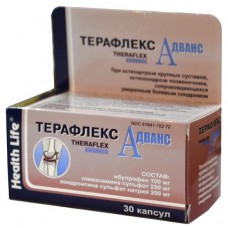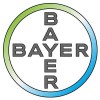Expiration date: 02/2026
Release form and composition:
Hard gelatin capsules, size No. 0, opaque, consisting of a blue cap and white body, with the inscription blue TERAFLEX ADVANCE the contents of the capsules mixed powder of white color with slight shades.
1 capsule contains:
glucosamine sulfate 250 mg
chondroitin sulfate sodium 200 mg
ibuprofen 100 mg
Excipients: cellulose microcrystalline, starch maize, starch pregelatinized, stearic acid, sodium carboximetilkrahmal, crospovidon, magnesium stearate, silicon dioxide, povidone.
The composition of the gelatinous capsules: gelatin, titanium dioxide, FDampC Blue No. 1 lacquer.
60 PCs. - bottles plastic (1) - packs of cardboard.
120 PCs. - bottles plastic (1) - packs of cardboard.
Pharmacological action:
The drug, stimulating the process of regeneration of cartilage with anti-inflammatory action.
Chondroitin sulfate sodium is an additional substrate for the formation of healthy cartilage matrix. Hyaluronan stimulates the synthesis of proteoglycans and type II collagen, and also protects gialuronon from enzymatic degradation (by inhibiting the activity of hyaluronidase) supports the viscosity of synovial fluid, stimulates cartilage repair mechanisms and inhibits the activity of those enzymes (elastase, hyaluronidase) that break down cartilage. In the treatment of osteoarthritis relieves symptoms and reduces the need for NSAIDs.
Glucosamine sulfate promotes the synthesis of proteoglycans, hyaluronic, chondroitinase acids and other substances in the composition of the articular membranes, intra-articular fluid and cartilage.
Ibuprofen is a propionic acid derivative and has analgesic, antipyretic and anti-inflammatory effect due to non-selective blockade of COX-1 and COX-2.
Contained in the product glucosamine sulfate and chondroitin sulfate potentiate the analgesic effect of ibuprofen.
Pharmacokinetics:
Glucosamine sulfate
Suction
Glucosamine bioavailability when taken orally is 25% (due to the first pass effect through the liver), the greatest concentration found in the liver, kidneys and articular cartilage. About 30% of the dose long persist in bone and muscle tissue.
Excretion
Write mainly with urine in unchanged form, partly with faeces. T1/2 of 68 h
Chondroitin sulfate
Suction
More than 70 % chondroitin sulfate is absorbed in the digestive tract. Bioavailability is about 13%. After a single oral therapeutic dose Cmax in plasma achieved through 3-4 h, in the synovial fluid - through 4-5 h.
Distribution and excretion
Absorbed in the gastrointestinal tract, the drug accumulates in synovial fluid. Excreted by the kidneys.
Ibuprofen
Absorption and distribution
Ibuprofen is well absorbed from the stomach. Cmax in plasma achieved through 1 h. Ibuprofen is approximately 99% bound to plasma proteins. Slowly is distributed in the synovial fluid and removed from it more slowly than from plasma.
Metabolism
Ibuprofen is metabolized in the liver mainly by hydroxylation and carboxylation of the isobutyl group. In the metabolism of the drug is involved isozyme CYP2C9. After absorption of about 60% pharmacologically inactive R-form of ibuprofen slowly transformirovalsya in the active S-form.
Excretion
Ibuprofen has a biphasic excretion kinetics. T1/2 from plasma is 2-3 h. To 90% of the dose can be detected in the urine as metabolites and their conjugates. Less than 1% excreted unchanged in the urine and, to a lesser extent in the bile. Ibuprofen be evacuated for 24 hours
Indications:
- osteoarthritis of large joints
- osteochondrosis of the spine, accompanied by moderate pain.
Dosing regimen:
Adults appoint 2 capsules 3 times/day after meal. Capsules are taken orally, squeezed small amounts of water. The duration of intake without consulting a doctor must not exceed 3 weeks. Continued use of the drug should be agreed with your doctor.
Side effects:
In applying the drug terafleks® advance nausea, abdominal pain, flatulence, diarrhea, constipation, allergic reactions. These reactions disappear after discontinuation of the drug.
You should consider the possibility of adverse reactions related to members of the drug ibuprofen. When using drugs ibuprofen in higher doses than is contained in the drug terafleks® advance, you can meet the following undesirable phenomena.
From the digestive system: NSAID gastropathy (abdominal pain, nausea, vomiting, heartburn, decreased appetite, diarrhoea, flatulence, constipation rare — ulceration of the gastrointestinal mucosa, which in some cases are complicated by perforation and bleeding) irritation or dryness of the mucous membrane of the mouth, pain in the mouth, pitting mucous membrane of the gums, aphthous stomatitis, pancreatitis, hepatitis, increased activity of transaminases.
The respiratory system: dyspnea, bronchospasm.
CNS: headache, dizziness, insomnia, anxiety, nervousness, irritability, psychomotor agitation, drowsiness, depression, confusion, hallucinations, rarely - aseptic meningitis (more often in patients with autoimmune diseases).
From the sensory organs: hearing impairment (hearing loss, ringing or roaring in the ears), visual disturbances (toxic damage to the optic nerve, blurred vision or double vision, scotoma, dryness and irritation of the eyes, swelling of the conjunctiva and eyelids allergic Genesis).
From the side of cardiovascular system: cardiac failure, tachycardia, increased blood pressure.
From the urinary system: acute renal insufficiency, allergic nephrite, nephrotic syndrome (hypostases), polyuria, cystitis.
With the hematopoietic system: anemia (including hemolytic, aplastic), thrombocytopenia, thrombocytopenic purpura, agranulocytosis, leukopenia, possible reduction of hemoglobin or hematocrit.
From the blood coagulation system: possible increase in bleeding time.
Allergic reactions: skin rash (usually erythematous), urticaria, pruritus, angioedema, anaphylactoid reactions, anaphylactic shock, bronchospasm or dyspnea, fever, exudative erythema multiforme (including Stevens-Johnson syndrome), toxic epidermal necrolysis (Lyell's syndrome), eosinophilia, allergic rhinitis.
Laboratory parameters: may decrease the concentration of glucose in serum, decrease creatinine clearance, increase in serum creatinine.
Contraindications:
- erosive and ulcerative diseases of the digestive tract (including gastric ulcer and duodenal ulcer in acute, Crohn's disease, ulcerative colitis)
- aspirin asthma
- hemophilia and other blood clotting (hypocoagulation)
- hemorrhagic diathesis
- gastrointestinal bleeding and intracranial hemorrhage
- pregnancy
- lactation (breast-feeding)
- children up to age 12 years
- hypersensitivity to any of the ingredients in the drug
- hypersensitivity to acetylsalicylic acid or other NSAIDs in history.
With caution should designate product in heart failure, arterial hypertension, liver cirrhosis with portal hypertension, hepatic and/or renal failure, nephrotic syndrome, hyperbilirubinemia, gastric ulcer and duodenal ulcer (in history), gastritis, enteritis, colitis, blood disorders unclear etiology (leukopenia and anemia), asthma, diabetes, and elderly patients. Intolerance seafood (shrimp, clams), the likelihood of allergic reactions to the drug increases.
Pregnancy and lactation:
The drug is contraindicated during pregnancy and breastfeeding.
Special instructions:
During long-term treatment needed to be monitored picture peripheral blood and functional state of the liver and kidneys.
If you see symptoms of gastropathy shows careful monitoring, including conducting esophagogastroduodenoscopy, blood test with determination of hemoglobin, hematocrit, fecal occult blood.
If necessary, the simultaneous reception of additional NSAID and analgesic drugs the doctor should note the presence in the drug ibuprofen. If necessary, additional long-term use of NSAIDs should be used the drug terafleks®, which contains ibuprofen.
If necessary, determine the 17-ketosteroids drug should be discontinued for 48 h before the study.
During treatment is not recommended reception alcohol.
Effects on ability to drive vehicles and management mechanisms
Patients should refrain from activities, require greater attention, rapid mental and motor responses.
Overdose:
The symptoms (associated with ibuprofen): abdominal pain, nausea, vomiting, lethargy, drowsiness, depression, headache, tinnitus, metabolic acidosis, coma, acute renal failure, decrease in blood pressure, hyperkalemia, bradycardia, tachycardia, atrial fibrillation, respiratory arrest.
Treatment: gastric lavage (only effective within 1 h after administration), activated carbon, the alkaline drink, forced diuresis, symptomatic therapy (correction of acid-base status, AD).
Drug interactions:
Inducers of microsomal oxidation (phenytoin, ethanol, barbiturates, rifampicin, phenylbutazone, tricyclic antidepressants) increase the production of hydroxylated active metabolites, increasing the risk of developing severe hepatotoxic reactions.
Inhibitors of microsomal oxidation reduce the risk of hepatotoxicity.
The drug reduces hypotensive effect of vasodilators (including blockers of slow calcium channel and ACE inhibitors).
The drug reduces natriuretic and diuretic activity of furosemide and hydrochlorothiazide.
Reduces the effectiveness of uricosuric drugs.
Enhances the action of indirect anticoagulants, antiplatelet agents, fibrinolitikov (increase the risk of hemorrhagic complications).
Enhances the ulcerogenic action (with the development of bleeding) corticosteroids, NSAIDs, colchicine, estrogens, ethanol.
Enhances the effect of oral hypoglycemic drugs and insulin.
Antacids and cholestyramine reduce the absorption of ibuprofen.
Increases concentration in blood of digoxin, drugs lithium and methotrexate.
Caffeine increases the analgesic effect Teraflex advans.
While the appointment of ibuprofen reduces inflammatory and antiplatelet action of acetylsalicylic acid (may increase the incidence of acute coronary insufficiency in patients receiving as angioprevention means of small doses of acetylsalicylic acid after the administration of ibuprofen).
In the appointment with the anticoagulant and thrombolytic drugs (alteplase, streptokinase, urokinase) can also increase the risk of bleeding.
Cefamandole, cefoperazone, cefotetan, valproic acid, plicamycin increase the frequency of gipoprotrombinemii.
Myelo-toxic drugs increase the symptoms of blood toxicity.
Cyclosporine and preparations gold strengthen the effect of ibuprofen on prostaglandin synthesis in the kidneys, which is manifested by increased nephrotoxicity.
Ibuprofen increases the plasma concentration of cyclosporine and the likelihood of its hepatotoxic effects.
Drugs that block tubular secretion, reduce the excretion and increase plasma concentrations of ibuprofen.
In connection with the content of the preparation of glucosamine may decrease the effectiveness of hypoglycemic drugs, doxorubicin, teniposide, etoposide.
Glucosamine increases removals tetracycline, reduces the effects of semisynthetic penicillins, chloramphenicol.
Terms and conditions of storage:
The drug should be stored in a dry, dark, inaccessible to children place at temperature not exceeding 25°C. shelf Life - 2 years.




